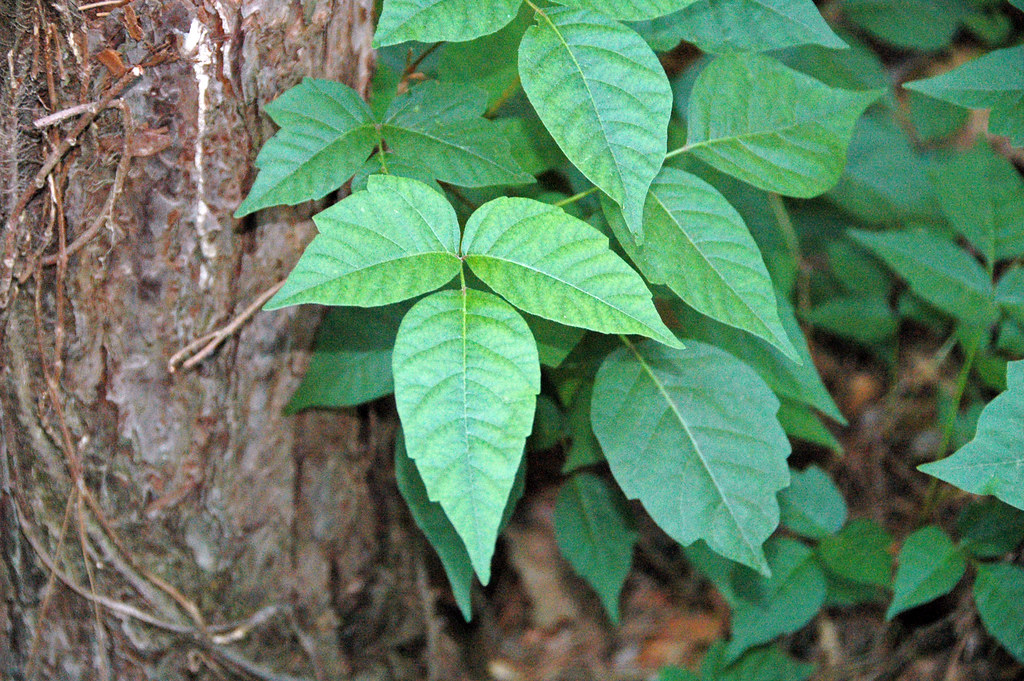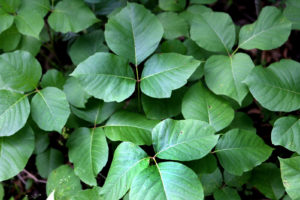How To Clear Poison Ivy From Yard

Getting rid of poison ivy in your yard can be a loathsome venture. You risk exposing yourself to the plant's toxins, and it takes real persistence to keep those leaves at bay.
Poison ivy can be a burden for those allergic to the plant's toxic oils. Even when you and your children stay far away, your pet may roll through the plant and spread the oils to your skin. We're here to help you identify this nuisance plant, safely remove it from your yard, and avoid or get rid of that poison ivy rash.
What Does Poison Ivy Look Like?

If you're on a quest to remove poison ivy from your yard or garden, you'll need to know what this plant looks like. Recognizing poison ivy by its leaves can be one of the easiest ways to identify the plant.
You've heard it before: "Leaves of three, leave them be." Poison ivy has compound leaves with three leaflets. A compound leaf is a leaf consisting of separate parts (leaflets) joined together by one stem.
The middle leaflet has the most extended stalk, while the adjacent leaflets grow attached to the main stem. The shape of poison ivy leaves can vary. Leaflets can be elliptical or egg-shaped and have smooth, jagged, or lobed edges.
Each compound leaf has three bright green leaflets. The leaflet's upper surface is smooth and hairless, while small hairs typically grow on the underside of the leaf's veins. The presence of hairs can vary.
Poison ivy can grow in a variety of ways, depending on its environment. It's varying growth habits can sometimes make it challenging to identify. It can grow up trees with hairy aerial rootlets, grow along the ground, creep up buildings, and have a shrub-like appearance.
How to Get Rid of Poison Ivy in Your Yard
Poison ivy has an extensive root system, making any attempt at outsmarting poison ivy a challenge. Controlling poison ivy also comes with the risk of exposure.
Always wear protective gear when dealing with poison ivy in your yard:
- Long pants
- Long-sleeve shirts
- Closed-toe shoes
- High socks
- Gloves, either heavy-duty or waterproof
Anyone wanting to rid their yard of poison ivy must be persistent and protect themselves accordingly. Wash all clothes, shoes, and equipment after exposure.
Natural methods to remove poison ivy
- Hand-pull: Using waterproof, heavy-duty, or rubber gloves, hand-pull individual poison ivy plants from your yard. Hand-pulling requires consistency, as the extensive root system will allow the plant to regrow. Wash those gloves, thoroughly.
- Cutting or mowing: Persistent clipping or mowing of poison ivy near ground level may control poison ivy after a few years.
Chemical methods to remove poison ivy
- Herbicides: The University of Georgia Extension recommends using the herbicides glyphosate, Triclopyr, and 2,4-D, to control poison ivy. For effective control, you may need to perform multiple herbicide applications. Follow all labeled instructions before use to ensure safety and best results.
When to call a lawn care pro for help
If you have difficulty removing poison ivy from your yard, call a lawn care professional who will have the right solutions to protect you and your family from this aggressive, rash-inducing plant.
How to Get Rid of Poison Ivy on Your Body
Poison ivy leaves produce urushiol (a toxic plant oil) when crushed, bruised, brushed, chewed, or damaged. When humans brush against poison ivy, they cause the leaves to bruise and release the urushiol. If the toxic oil touches the skin, a severe reaction may occur.
Poison ivy, poison oak, and poison sumac are different poisonous plants, but they all contain urushiol.
Exposure to the toxin can also occur when people touch the equipment, clothes, furniture, or animals contaminated with the oil. Smoke can also carry toxic particles if poison ivy is burning.
Keep in mind that poison ivy cannot spread from person to person. The rash is also not contagious to other parts of your body. So if you do scratch your rash, you cannot spread it by touching another part of your body. But if you have not washed the affected area and the toxin is still on the skin, you can spread it to other parts of the body.
If the rash appears to be spreading, you may be re-exposing yourself to the toxin by wearing contaminated clothes. Some parts of the body may also have a delayed reaction to the exposure, making it appear the rash is spreading. The liquid inside the rash's blisters does not spread poison ivy.
What does a poison ivy rash look like?
A poison ivy rash can appear as thin red lines on the skin where the poison ivy leaves brushed against you. If you have lots of exposure to the plant, interact with an affected animal, or wear contaminated clothing, then the rash can appear in large patches on the body. The rash can appear as soon as 12 hours after exposure and last for two to three weeks. Some people may have no allergic reaction to poison ivy.
Symptoms of poison ivy rash include:
- Swelling
- Redness
- Itching
- Blisters
- Difficulty breathing after inhaling the smoke of burning poison ivy
What to do if you touched poison ivy
If you believe you've touched poison ivy or urushiol, rinse the skin with cold water as soon as possible. Cold water may keep the urushiol away from your skin if done within five minutes of exposure. Use soap and water if the contact occurred within 30 minutes.
Wash any clothes, pets, equipment, or furniture fabric that may have come in contact with the oil. You may also use rubbing alcohol to help remove the toxin from the skin soon after exposure.
How to treat a poison ivy rash
Urushiol can be a severe irritant. A poison ivy rash will usually go away on its own within two to three weeks. But sometimes poison ivy's itchy rash can be unbearable as it rubs against your clothes or prevents you from sleeping.
The Mayo Clinic recommends these home remedies to help soothe and heal your rash:
- Corticosteroid cream: For the first few days of the rash, apply an over-the-counter corticosteroid cream.
- Calamine lotion: Apply calamine lotion to the rash.
- Oral antihistamines: Take oral antihistamines, such as diphenhydramine (Benadryl), which may help you sleep better.
- Take a bath: Soak in a cool-water bath containing an oatmeal-based bath product.
- Cool compresses: Place cool, wet compresses on the affected area for 15 to 30 minutes several times a day.
- Baking soda: The FDA recommends applying baking soda or colloidal oatmeal to relieve minor irritation and itching.
See your primary care doctor for poison ivy treatment if the rash is widespread, has several blisters, or does not heal after three weeks. Your doctor may prescribe an oral corticosteroid, such as prednisone, or refer you to a dermatologist. If your rash has developed an infection, your doctor may prescribe an oral antibiotic.
Main Image Credit: James St. John, CC BY 2.0

Jane Purnell
Jane Purnell is a freelance writer and actor in New York City. She earned her B.A. from the University of Virginia and enjoys a warm cup of French press coffee.
How To Clear Poison Ivy From Yard
Source: https://www.lawnstarter.com/blog/lawn-care-2/how-to-get-rid-of-poison-ivy/
Posted by: gonzalesandlever.blogspot.com

0 Response to "How To Clear Poison Ivy From Yard"
Post a Comment